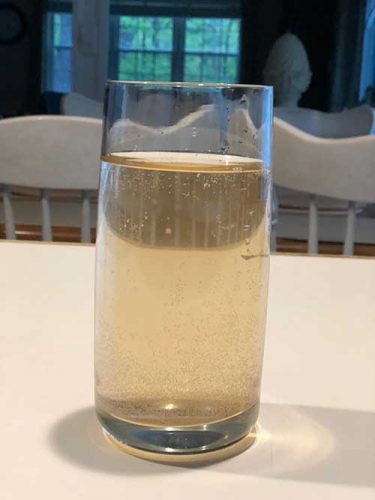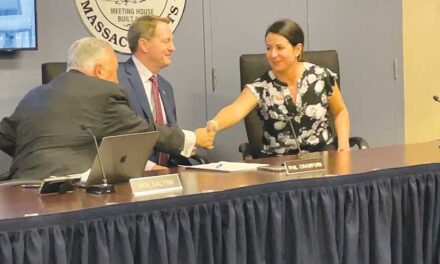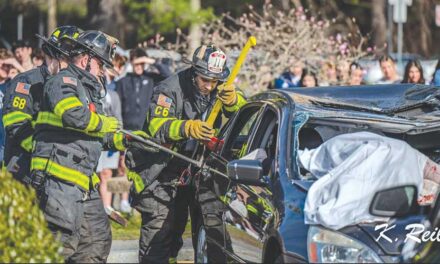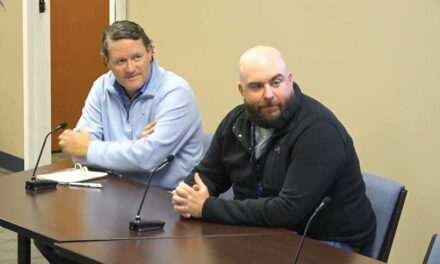Published in the May 23, 2018 edition
By DAN TOMASELLO
LYNNFIELD — A group of residents are concerned about the condition of water located in portions of the Lynnfield Center Water District (LCWD).
The problem has mainly impacted the Cortland Lane, Apple Hill Lane and Lowell Street sections of town. While most communities get water from one source such as North Reading via the town of Andover and Wakefield through the Massachusetts Water Resource Authority (MWRA), Lynnfield has two distinct water districts that serve as independent governmental agencies.
The Lynnfield Center Water District, which was established by an act of the State Legislature in 1939, provides water to Lynnfield Center that comes from the district’s wells. The Lynnfield Water District was established by the State Legislature in 1924, and serves the southern part of town by purchasing its water from the MWRA.
Cortland Lane resident Marie Lagman has been one of the residents concerned about the water in her home, and has been leading the charge on the Lynnfield Community Group Facebook page. She said in an email sent to the Villager the situation has caused a number of financial problems including replacing damaged clothing, sheets and towels after they were stained while being washed. She said the most recent occurrence took place last week.

CORTLAND LANE RESIDENT Marie Lagman submitted this photo of discolored water to Lynnfield Center Water District and local officials. A public hearing on the LCWD water issues will take place on Monday, June 4.
“My father had to go to the store to buy new T-shirts and underwear because his were all ruined from discolored water in a previous load of laundry,” wrote Lagman in an email sent to local and LCWD officials. “He ran those brand new, straight-out-of-the-package, white replacement T-shirts and underwear in the laundry and guess what? Ruined again. It’s beyond frustrating. My poor mother was nearly in tears.”
Lagman also said the LCWD water issues have ruined meals and forced her family to rewash dishes because they were stained by discolored water. In addition, she explained the problem has impacted her family’s shower schedule. She also said the problem has her concerned about her family’s safety.
After contacting LCWD officials about discolored water, Lagman received an email from LCWD’s Christine Smallenberger on April 30 that was obtained by the Villager.
Smallenberger wrote that LCWD “had been to Cortland Lane a few weeks ago (April 10) and spent a good amount of time flushing out the hydrant.”
“In the past year, the superintendent (Ken Burnham) has been working with our engineering firm, Camp Dresser McKee (CDM), in completing a hydraulic study of the system and (together they) are working on a program to do some directional flushing with respect to this specific area (Cortland/Apple Hill) in order to eliminate the problem and address the concerns for this area,” Smallenberger wrote.
In response to Smallenberger’s email, Lagman inquired “if the hydrants were flushed on April 10, why are we still intermittently seeing discolored water threes week later?” Lagman told the Villager she never received a response from the LCWD.
Murphy Way resident Amy Sewyck said the LCWD problem has been “an ongoing issue for close to two years.”
“It happens during any time of the year,” said Sewyck in an email sent to the Villager. “It is not specific to spring or any other season. At first I thought the contaminants were dirt. When I believed it was dirt, I was not as concerned. However, I did place a phone call prior to these recent incidents. I also purchased a Brita Water Filter for my tap water that I kept in my refrigerator for drinking water. Upon keeping a sample that came out of my faucet on April 21 at 9:55 a.m., I realized that the sediments settled to the bottom of the glass and that they were clearly not dirt.”
Sewyck said she contacted Burnham, who told her the problem “was due to my location because I live on a hill and street sweeping.”
“I had called in the past and received a similar response,” said Sewyck. “I was told it was normal and nothing to be concerned about. Mr. Burnham told me he knew exactly what was in the water and that I have nothing to be concerned about. He also told me that he has not seen the water and cannot fix a problem that he did not know about.”
Lowell Street resident Erin Denehy has been experiencing similar problems since moving to town in June 2017.
“The water is often the color of black tea with a significant amount of rust colored matter that settles at the bottom,” said Denehy in an email sent to the Villager. “I’ve been told that this is ‘normal’ and ‘safe’ to consume and is a result of a change in flow likely due to an increase in demand (due to) many people watering lawns, street sweeping or use of a hydrant in town. We continued to experience the discoloration throughout the winter, so I do not believe the problem is likely due to watering lawns and other events leading to an increase in the demand of water.”
Denehy said the problem has continued after LCWD undertook recent flushing.
“For us, it has certainly not corrected the problem,” said Denehy. “We continue to experience the discoloration post-flushing and have since had the (LCWD) visit our house. They again told me that this is likely due to a change in demand and that is ‘normal.’ I do know of other residents in our area that have the same experiences, but it seems to be isolated to our particular area.”
In the wake of the residents’ concerns, the Board of Selectmen and LCWD will be holding a joint meeting on the water issues on Monday, June 4, beginning at 7:30 p.m. in the Al Merritt Center. Burnham, LCWD Water Commissioners and LCWD’s engineering firm, CDM Smith, will be giving a presentation on the operations, practices, and oversight of the district as well as long-term and short-term capital plans.
“It is important to the Board of Selectmen that the town work cooperatively with these important agencies,” said Selectmen Chairman Dick Dalton in a statement. “Members of the board have heard concerns, so it is appropriate that we provide a forum for Center Water District to provide residents with information about operations and practices and share their plans for the future with their customers. We invite all interested parties to attend.”
LCWD responds
In an interview with the Villager, Burnham attributed the discolored water problems to manganese and iron that have been built up in water pipes. In order to correct the problem, he said the LCWD plans on building a new water plant on Glen Drive.
“CDM is in the process of designing a plant similar to the one on Phillips Road so we can filter the iron and manganese out,” said Burnham.
While the LCWD is going to be building a new plant, Burnham said it will take about two years to construct it because the district needs to go through the permitting process that requires approval from the Massachusetts Department of Environmental Protection and Environmental Protection Agency.
“Until then, we are going to continue directional flushing,” said Burnham.
According to a MassDEP handout provided by LCWD officials, “water main flushing moves water systematically through sections of a drinking water distribution system, creating a scouring action to clean the line.”
“The increased flow rate scours the water pipe’s inner walls and helps to remove build-up of naturally occurring debris and sediment,” MassDEP wrote.
MassDEP stated using water during flushing “may result in staining or sediment in laundry, ice machines, dishwasher, bathtubs or hot water tanks.”
If water appears dirty after flushing takes place, MassDEP encourages residents to “run a cold water tap closest to your meter, usually found in the basement or a first floor sink, for a few minutes up to 15 minutes.”
“Keep the tap open until the water runs clear,” MassDEP wrote. “If you have trouble seeing if the water is clear, fill a light or white color cup or container to view the water. If the water coming from the tap is not clear after running for 15 minutes, wait 15-30 minutes and try again. Do not run a tap that has a water filter connected to it or the sediment may clog your filter. Avoid running a hot water tap because it could draw sediment into your hot water tank.”
Burnham told the Villager “the water is safe.” He noted the water has been sent to the MassDEP and EPA in order to be tested. He said the water has been tested more than state regulations require.
“We are not trying to cover anything up,” said Burnham. “We are trying to be proactive, which is why we do more testing than we are required to do. The perception we haven’t been proactive is way off-base.”
LCWD Water Commissioner Richard Lamusta agreed.
“We have been proactive for a long time in this area,” said Lamusta.
An LCWD employee who did not give his name said the district has received a total of eight complaints about discolored water.
Burnham said in a statement sent to the Villager that LCWD officials are looking forward to discussing the matter with residents and the selectmen on June 4.
“The Lynnfield Center Water District wants to assure residents that our water is safe for drinking, is regularly tested and meets all federal and state standards,” said Burnham. “We are happy to inform the residents about the measures we are taking to ensure that our drinking water remains safe for residents and to improve our systems.”




